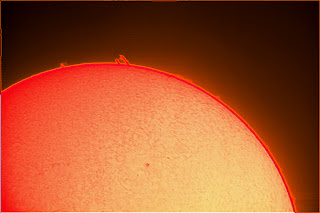This is a brief summary of my early attempts at measuring the light curves for short period binary stars. My initial attempt has been sort of a proof of concept using Algol as a target.
Objective:
Produce a light curve of the minimum of the transit of Algol
Equipment:
- Canon xTi
- Standard photography tripod
- Canon remote timer
During the late fall and winter Algol is in an excellent location in the sky for photography. To complete the light curve analysis I'm looking for its not actually necessary to photograph the entire period of the binaries rotation; photographing the length of the minimum is the primary goal. Fortunately for me Algol has been well studied and the time of the minimum on any given day is available on the Sky and Telescope website:
Sky & Telescope Algol Minimum Calculator
The Algol binary system has a period of 2.8 days and the transit of Algol b takes 10 hours from start to finish. Ideally this entire transit is what should be photographed. However this requires 10 hours of clear dark skies during which the minimum occurs. This is rare and so far I haven't been able to photograph more than a few hours at a time.
Results:
This past weekend I attended the Alberta Science Teachers Conference in Banff and Thursday November 15th at 11:56 pm was a predicted minimum of Algol. So after the conference ended I set up my camera and recorded about an hour of photos immediately up to the minimum. After gathering twenty seven 20 second pictures at three minute intervals I converted the .raw files to .tiff files using photoshop. I was able to analyze these images using SalsaJ and came up with some encouraging data.
Below is a quick time lapse of the images I took. Some of the pictures were effectively ruined by transient clouds but enough suitable images were obtained to provide a rudimentary proof of concept.
Using the best 7 data points I was able to using the photometry features of SalsaJ to gather the data below:
| Image # | Start Time | Target Intensity | Comparison Intensity | Magnitude Ratio |
| 1 | 21:53:00.00 | 3519840 | 4879236 | 0.72139 |
| 2 | 22:55:00.00 | 3402002 | 4836478 | 0.70340 |
| 3 | 22:57:00.00 | 3819125 | 5215910 | 0.73221 |
| 4 | 22:59:00.00 | 3773813 | 5597030 | 0.67425 |
| 5 | 23:01:00.00 | 3691644 | 5714231 | 0.64604 |
| 6 | 23:03:00.00 | 3980940 | 6143964 | 0.64794 |
| 7 | ||||
| 8 | ||||
| 9 | ||||
| 10 | ||||
| 11 | ||||
| 12 | ||||
| 13 | ||||
| 14 | ||||
| 15 | 23:27:00 | 2907813 | 4760742 | 0.61079 |
| 16 | ||||
| 17 | 23:33:00 | 3614116 | 6708249 | 0.53876 |
For the photometric analysis the comparison star was Mirfak. Using the ratio of Mirfak to Algol during the image run I created the light curve:
Analysis:
These results are encouraging. Even though the weather resulted in a large gap in the data and there are relatively few points, they consistently show a decrease as the expected minimum approaches. I'm further encouraged because of the specific results of the photometry. Mirfak is not a variable star and has an apparent magnitude of 1.8. At its minimum Algol has a magnitude of 3.4. The ratio of magnitudes of Mirfak/Algol at the minimum of Algol is 0.529 which is very close to 0.538. The deviation could easily be explained by the time difference between my last observation (11:33 pm) and the time of the expected minimum (11:54) or the effects of clouds on the observations.
Conclusion:
While this isn't conclusive I'm quite encouraged by my results. I've been convinced this method will eventually yield successful results when the weather and transit times allow me to make further observations. If you have any suggestions or comments I'd be happy to hear them.
Conclusion:
While this isn't conclusive I'm quite encouraged by my results. I've been convinced this method will eventually yield successful results when the weather and transit times allow me to make further observations. If you have any suggestions or comments I'd be happy to hear them.



























